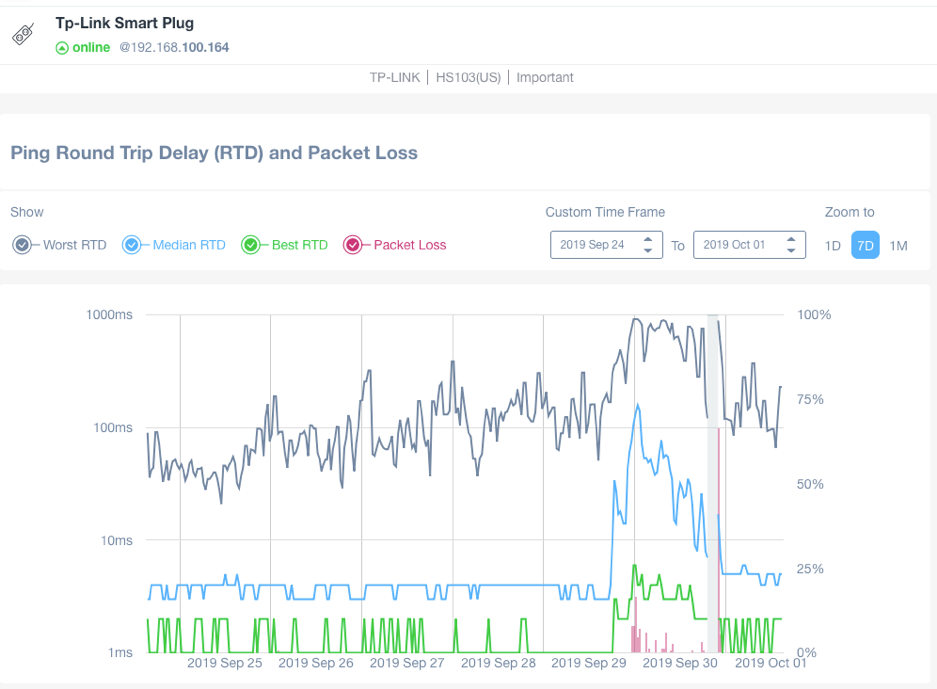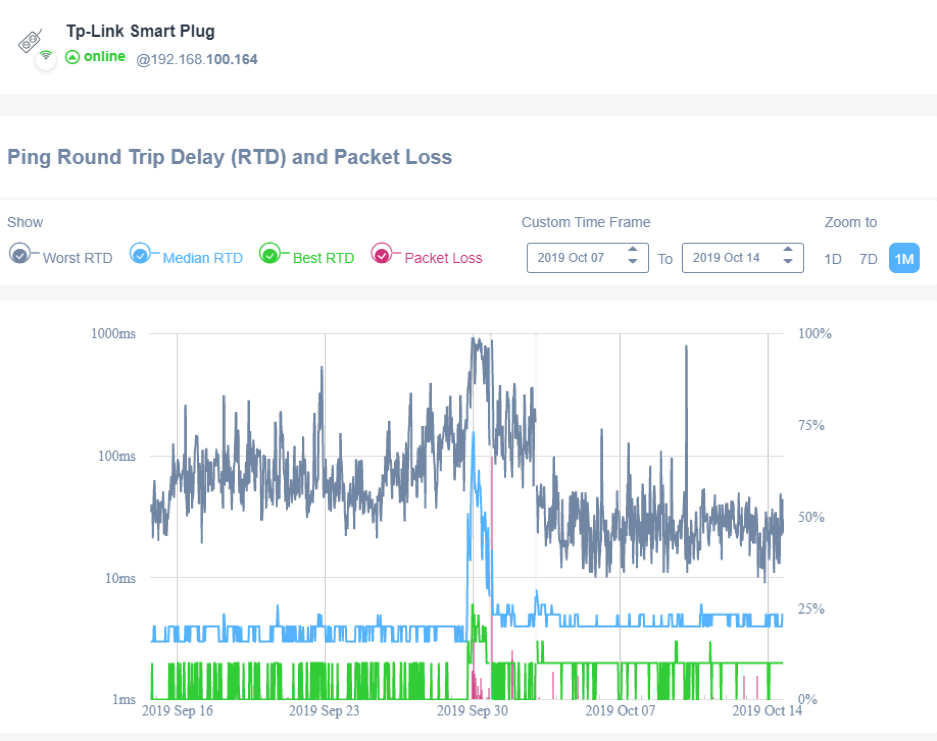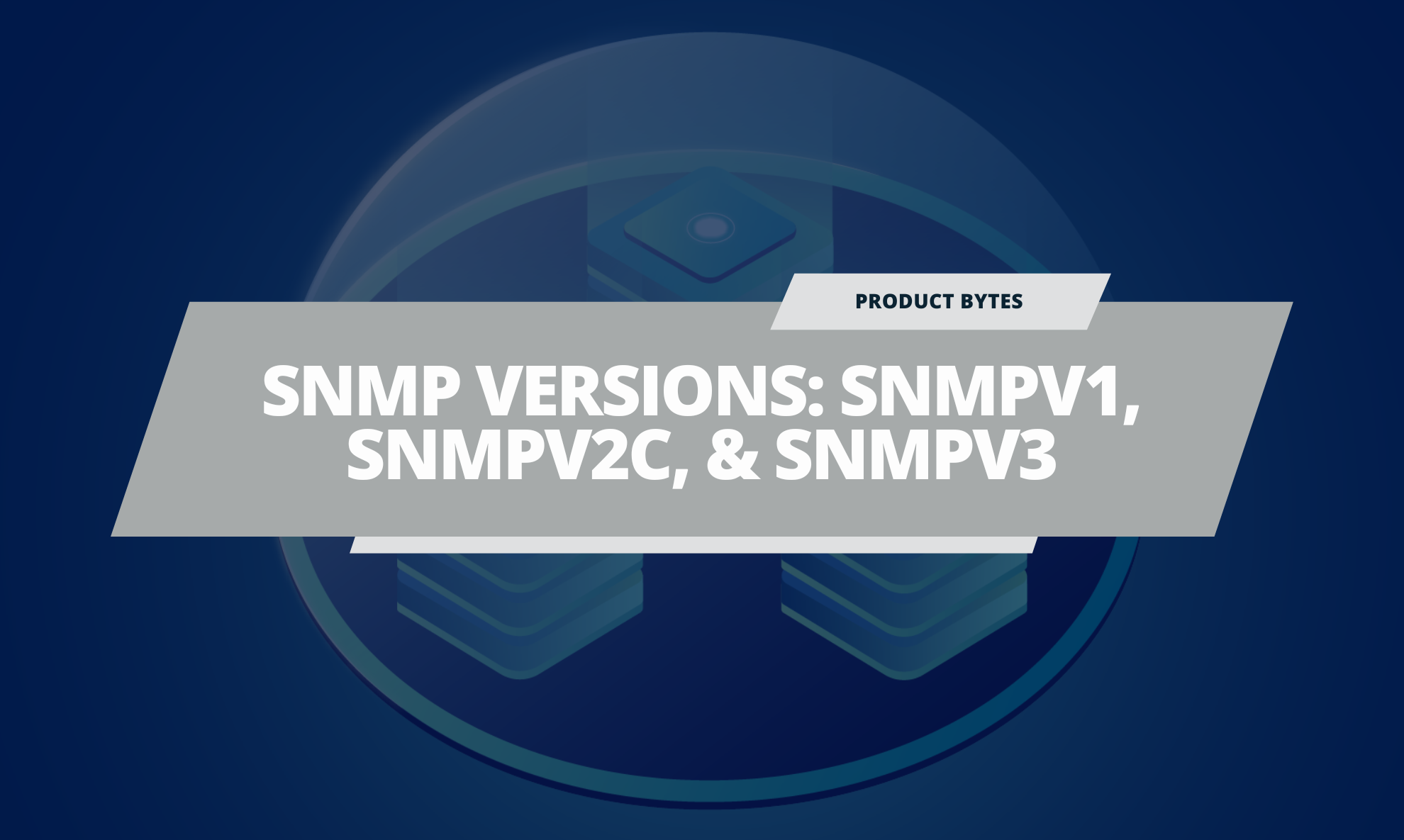September 1, 2020

What is Network Round-Trip Delay?

Network Round Trip Delay Impact Application Performance?
Round trip delay (RTD), a.k.a. Round trip time (RTT), or ping time, is the duration of time it takes for a signal to reach its destination across a network and then for an acknowledgment signal to return to the originator. This measurement includes all delays caused by routing, transmission medium, and network traffic. The return signal does not have to follow the same path that the initial signal took.
How do you measure Network Round-Trip Delay?
Using standard ping tools found on most computers, network round trip delay can be tested easily from the command line. The ping time or ping rate is typically measured in milliseconds (ms). The standard ping is measured for either Round Trip Time (RTT) or Time to First Byte (TTFB). RTT is the total time it takes for a data packet to go from the client and return from the server, and it is the standard reporting measurement. TTFB is the time it takes for the server to get the first byte of client data, and should be half the time as RTT on the same path.
Application Performance and Network Round Trip Delay
Impact of RTT on Application Performance
Round trip delay is closely related to network latency. RTD is the measure on which network latency and network jitter are calculated, and because of this, it shares the same impacts that latency and jitter have on quality of service (QoS). As RTD increases so does network latency, and as the variance between RTDs in a transmission increases so does the jitter.
What are the factors that impact Round-Trip Delay (RTD)?
- Transmission Medium—Network traffic speed is limited by the physical connections that it travels through. Because a signal can only travel as fast as the medium of transport allows, understanding the slowest and fastest mediums along a signals route becomes crucial in controlling RTD. For example, fiber optic cable is roughly 100x faster than coax cable, and over greater distances mostly fiber optic is used. However, leading into most homes, some variation of metal cable is used for the internet. This means, at these points of medium change, we can expect there to be transmission delays as signal slows down to when passing from fiber optic to travel across the copper medium. Further, inside the home or office, the signal may then be sent to computers via wifi, changing medium once again.
- Local Area Network Traffic—Local network traffic causes congestion which can bottleneck the network. This directly impacts both transmitting and receiving signals from connected devices. For example, the use of streaming services by multiple devices on the same network will cause congestion, but for other users trying to send and receive transmissions they may experience increases in RTD.
- Server Response Time—On the opposite side of a transmission from the requesting user is the server response. How quickly a server can respond to a request will impact the RTD. In fact, this is a classic attack by cybercriminals, known as a denial-of-service attack (DoS) when a server is flooded by requests in order to overload it and either stall access or deny it completely. Based on this example, the main principle for servers is the number of requests it must attend to, the greater the amount, the more likely it will impact RTD .
- Internet Routing And Congestion—Perhaps the aspect affecting round trip delay that is least controlled by IT departments is the routing of a signal across the internet. A signal travels from sender to receiver and back through a route that will pass through any number of nodes along the internet. Each node has its own network traffic that the signal must pass through, which factors into the RTD calculation. Generally the greater number of nodes that the signal travels through the more congestion it must contend with and ultimately the longer the signal will take.
- Physical Distance Of Transmission—Closely related to the transmission medium, the physical distance a signal must travel to reach its destination is limited by the laws of physics and the speed of light. In most long distance transmissions, fiber optics use light to send massive amounts of data efficiently, but even that is not instantaneous.
Related Terms
Network Latency
Network latency is the duration of time it takes a data packet to travel from its source to its destination across a network. In terms of user experience, network latency translates to how fast a user’s action produces a response from a network, say how quick a web page accesses and loads over the internet, or the responsiveness of an online game to the gamer’s commands.
Experience what better network management looks like.
Related Assets

How to Set Network Monitoring Alerts in LiveNX

Retooling NetOps for a Multi-Cloud Future Presented by EMA and LiveAction

Streaming Machine Learning
Solution briefs whitepapers.

RTD (Round Trip Delay)
Round Trip Delay (RTD) refers to the total time taken for a signal or data packet to travel from a source to a destination and then back again. It is a measure of the latency or delay experienced in a round trip communication between two points in a network.
RTD is typically measured in milliseconds (ms) or microseconds (μs) and is influenced by several factors, including:
- Propagation Delay: This is the time it takes for a signal to travel from the source to the destination. It depends on the distance between the two points and the speed of propagation in the medium through which the signal is transmitted. For example, in a fiber optic network, the propagation delay is relatively low due to the high speed of light in the optical fiber.
- Transmission Delay: This is the time taken to transmit the data over the network. It depends on the data rate (bandwidth) of the network connection. Higher bandwidth connections can transmit data faster, reducing the transmission delay.
- Processing Delay: This is the time taken by network devices, such as routers or switches, to process the data packets. It includes the time for packet forwarding, routing table lookups, and any other operations performed by the network devices.
- Queuing Delay: In a congested network, data packets may experience queuing delay when they are waiting in a buffer or queue to be transmitted. The queuing delay depends on the network congestion level and the priority given to different types of traffic.
To measure RTD, a device typically sends a test packet or a signal to the destination and measures the time it takes for the packet to return. This can be done using various tools or protocols, such as Internet Control Message Protocol (ICMP) ping or round-trip time (RTT) measurements in network monitoring tools.
RTD is an important metric for assessing network performance and quality of service. It is particularly critical in real-time applications, such as voice and video communication or online gaming, where low latency is crucial for a smooth user experience. High RTD can result in delays, packet loss, or degraded performance, affecting the overall quality of communication or application responsiveness.
Network administrators and engineers monitor RTD to identify and troubleshoot performance issues, optimize network configurations, or select the most suitable network paths or service providers for their requirements.
Improved Preamble Detection and Round-Trip Delay Estimation for Random Access in High-Mobility Airborne Communication Systems
Ieee account.
- Change Username/Password
- Update Address
Purchase Details
- Payment Options
- Order History
- View Purchased Documents
Implementing High-Speed Double-Data Rate (DDR) SDRAM Controllers on FPGA
- Conference paper
- Cite this conference paper

- Eduardo Picatoste-Olloqui 19 ,
- Francisco Cardells-Tormo 19 ,
- Jordi Sempere-Agullo 19 , 20 &
- Atilà Herms-Berenguer 20
Part of the book series: Lecture Notes in Computer Science ((LNCS,volume 3203))
Included in the following conference series:
- International Conference on Field Programmable Logic and Applications
1395 Accesses
This paper deals with the FPGA-implementation of a high-speed interface for DDR SDRAMs. We aim to achieve a performance, in terms of bandwidth, comparable to ASIC implementations. The novelty of this paper is to present the design techniques that lead to high performance memory controllers. First of all, we compile the specific hardware features available in FPGA families. In the second place, we depict a memory interface data path architecture adapted for implementation on Xilinx and Altera FPGAs. Finally, we explain the design rules to meet timing requirements (round trip delay) for successful operation. The discussion is complemented with timing measurements for a Virtex-II based memory interface and with timing calculations performed for Stratix.
This is a preview of subscription content, log in via an institution to check access.
Access this chapter
- Available as PDF
- Read on any device
- Instant download
- Own it forever
- Compact, lightweight edition
- Dispatched in 3 to 5 business days
- Free shipping worldwide - see info
Tax calculation will be finalised at checkout
Purchases are for personal use only
Institutional subscriptions
Unable to display preview. Download preview PDF.
Ryan, K.: DDR SDRAM Functionality and Controller Read Data Capture. Micron Design Line 8(3) (1999)
Google Scholar
JEDEC: JEDEC Standard Double Data Rate (DDR) SDRAM Specification, JESD79. Available on-line (2002)
Altera Corp.: DDR SDRAM Controller MegaCore Function User Guide. Available on-line (2004)
Northwest Logic: DDR SDRAM Controller. Datasheet. Available on-line (2004)
Tran, J.: Synthesizable DDR SDRAM Controller. Xilinx Application Note XAPP200. Available on-line (2003)
Altera Corp.: Using the Stratix and Stratix GX DDR Round Trip Delay (RTD) Calculator. Available from Altera under request (2003)
Download references

Author information
Authors and affiliations.
Hewlett-Packard, R&D Technology Lab., Digital ASICs, 08174, Sant Cugat del Valles (Barcelona), Spain
Eduardo Picatoste-Olloqui, Francisco Cardells-Tormo & Jordi Sempere-Agullo
Department of Electronics, University of Barcelona (UB), Marti i Franques 1, 08028, Barcelona, Spain
Jordi Sempere-Agullo & Atilà Herms-Berenguer
You can also search for this author in PubMed Google Scholar
Editor information
Editors and affiliations.
ITIV - Universitaet Karlsruhe (TH),
Jürgen Becker
University of Paderborn,
Marco Platzner
IMEC, Kapeldreef 75, Leuven, Leuven, Belgium
Serge Vernalde
Rights and permissions
Reprints and permissions
Copyright information
© 2004 Springer-Verlag Berlin Heidelberg
About this paper
Cite this paper.
Picatoste-Olloqui, E., Cardells-Tormo, F., Sempere-Agullo, J., Herms-Berenguer, A. (2004). Implementing High-Speed Double-Data Rate (DDR) SDRAM Controllers on FPGA. In: Becker, J., Platzner, M., Vernalde, S. (eds) Field Programmable Logic and Application. FPL 2004. Lecture Notes in Computer Science, vol 3203. Springer, Berlin, Heidelberg. https://doi.org/10.1007/978-3-540-30117-2_30
Download citation
DOI : https://doi.org/10.1007/978-3-540-30117-2_30
Publisher Name : Springer, Berlin, Heidelberg
Print ISBN : 978-3-540-22989-6
Online ISBN : 978-3-540-30117-2
eBook Packages : Springer Book Archive
Share this paper
Anyone you share the following link with will be able to read this content:
Sorry, a shareable link is not currently available for this article.
Provided by the Springer Nature SharedIt content-sharing initiative
- Publish with us
Policies and ethics
- Find a journal
- Track your research
Using RTD to analyze your Wi-Fi Networks and fix slow Wi-Fi

Feb 5, 2020
Henrique salvador, product bytes.
Recently, I started receiving alerts from Domotz that several devices were coming offline and online every few minutes. After some quick investigating, I realized that all the alerts were associated with devices that were connected to my Wi-Fi network and are located in my living room.
Ah ok… makes sense. I’ve always thought those are devices were a little too far away from my Access Point!
Domotz Round Trip Delay to the rescue

I opened the Domotz app, navigated to a smart plug that’s in my living room and noticed the RTD (Round Trip Delay) charts.
All devices had a higher latency starting on Sunday, even showing packet loss , which was not normal for some of the devices.
How I fixed my offline devices using RTD to analyze the Wi-Fi Network
The next day I changed my Wi-Fi channel and noticed a significant improvement.
On Monday night I checked the network to make sure that I had chosen the Wi-Fi channels correctly. I scanned my network using the Wi-Fi Analyzer and found that a neighbour of mine had overlapped the channels I was using before! Without Domotz I would never have figured that out. This is a huge benefit of Domotz real-time alerts and having the Domotz platform continually monitor the network .
Even after changing channels I decided to take things one step further, hoping I could improve the network even more. That week I added a new, additional AP in the room. Looking back at my Round Trip Delay chart, everything seems to be working much better now:

Even the tests with iPerf 3 have improved significantly with the new AP, see here before and after:

Sure, I may be a bit biased as a Domotz employee, this is the amazing value of having Domotz monitor my network and using the Round Trip Delay feature. Without Domotz I would not have seen this issue, and struggled to find a fix!
Share via Social Networks
You might also like…
Read more top posts in this category

What is a Network Management Tool, and Why Use One?
by Violet Chepil | Apr 23, 2024 | Product Bytes
5 min What is a network management tool and who should be using one?

SNMP v1, v2, and v3: What Are the Different SNMP Versions?
by Vanya Petrova | Apr 18, 2024 | Product Bytes
4 min Understanding SNMP versions: SNMPv1, SNMPv2c, and SNMPv3.

What is an SNMP Community String – How it Works
by Violet Chepil | Apr 12, 2024 | Product Bytes
4 min All about SNMP community strings and how they work.
Get the latest news about Domotz and top network and IT Infrastructure monitoring tips straight to your inbox by signing up for our monthly newsletter.
Signed up successfully!
Ready to get started with domotz.

IMAGES
VIDEO
COMMENTS
In telecommunications, round-trip delay (RTD) or round-trip time (RTT) is the amount of time it takes for a signal to be sent plus the amount of time it takes for acknowledgement of that signal having been received. This time delay includes propagation times for the paths between the two communication endpoints. In the context of computer networks, the signal is typically a data packet.
Round-trip time (RTT) is the time it takes for a packet to go from the sending endpoint to the receiving endpoint and back. There are many factors that affect RTT, including propagation delay, processing delay, queuing delay, and encoding delay. These factors are generally constant for a given pair of communicating endpoints.
In networking, round-trip time ( RTT ), also known as round-trip delay time ( RTD) is defined as a metric that measures in milliseconds the amount of time it takes for a data packet to be sent plus the amount of time it takes for acknowledgement of that signal to be received. This time delay includes propagation times for the paths between the ...
3. Round Trip Time. The RTT is the time between sending a message from a source to a destination (start) and receiving the acknowledgment from the destination at the source point (end). We can also see RTT referred to as Round Trip Delay (RTD). Sometimes, the acknowledgment is sent from the destination to the source almost immediately after the ...
Round trip delay (RTD), a.k.a. Round trip time (RTT), or ping time, is the duration of time it takes for a signal to reach its destination across a network and then for an acknowledgment signal to return to the originator. This measurement includes all delays caused by routing, transmission medium, and network traffic. ...
This time is called round-trip delay (RTD) and is highly dependent on the test station and the designs of the pin electronics and device interface board. As shown in Figure 1, ...
Round Trip Delay (RTD) refers to the total time taken for a signal or data packet to travel from a source to a destination and then back again. It is a measure of the latency or delay experienced in a round trip communication between two points in a network. RTD is typically measured in milliseconds (ms) or microseconds (μs) and is influenced ...
In telecommunications, the round-trip delay time (RTD) or round-trip time (RTT) is the length of time it takes for a signal to be sent plus the length of tim...
The Round-Trip Delay (RTD) of link (i, j) equals to d ij + d ji. In real networks, link delays may fluctuate frequently over time (e.g., vary for every millisecond (Zhang et al., 2017)). However, the frequent fluctuation does not reflect significant and persistent changes in network performance or trends (Guo et al., 2015). The goal of the ...
The Round-Trip Delay (RTD) of link ... In this work, we designed an efficient round-trip link delay measurement scheme for SDN networks, and to minimize measurement cost (i.e., the total cost of monitors, flow rules, and bandwidth) and fulfill monitor capacity constraint, we addressed the monitor placement and link assignment problem, whose ...
purposes through the normal course of business called Round Trip Delay (RTD), also referred to as Per Call Measurement Data (PCMD). PCMD is the measurement of the time required for the signal to travel from the cell site to the handset and then back to the cell site. PCMD provides an approximate distance of the mobile device from the cell site.
Round-trip delay (RTD), also called as round-trip time (RTT), is the time required for a signal pulse or packet to travel from a specific source node thru path consisting other nodes and back again. The round trip delay time can range from a few milliseconds (thousandths of a second) under ideal conditions between nearby spaced sensor nodes to ...
RTD is the amount of time it takes for a signal to be sent plus the amount of time it takes for acknowledgment of that signal having been received. The maximum round-trip delay difference refers to the time that maximum RTD minus minimum RTD in the cell. 3.2.1. Maximum round-trip delay difference calculation method
Round-Trip Delay Time (RTD) Return to glossary. The length of time it takes for a signal to be sent plus the length of time it takes for an acknowledgment of that signal to be received. This time delay therefore consists of the transmission times between the two points of a signal. Contact. Webinars. Blog. About. Corporate;
In this paper, an improved preamble detection and round-trip delay (RTD) estimation algorithm is proposed for random access, particularly in the context of airborne wireless communication systems. The proposed algorithm is capable of both combating large Doppler shifts occurring in high-mobility scenarios and dealing with the energy leakage problem caused by sampling misalignment at the ...
In Case 1, the application writes the value of 60 in the cal_rtd_usr field of the DELAY_CAL_RTD register. When the CPRI IP core measures the actual round-trip delay and sets the round_trip_delay field of the ROUND_TRIP_DELAY register to the value of 61, the CPRI IP core responds by moving the read pointer to decrease the pipeline length, and therefore the measured round-trip delay value, by ...
In fact, Eq. 5 reflects computation of round-trip propagation delay in RFC 3550 [8] where recording time A corresponds to (T S 2 − DLSR 2 ) and LSR to T S 1 .
Using the Stratix and Stratix GX DDR Round Trip Delay (RTD) Calculator. Available from Altera under request (2003) Google Scholar Download references. Author information. Authors and Affiliations. Hewlett-Packard, R&D Technology Lab., Digital ASICs, 08174, Sant Cugat del Valles (Barcelona), Spain. Eduardo Picatoste-Olloqui, Francisco Cardells ...
The round trip delay (RTD) in satellite scenario can be much larger than the RTD in terrestrial network. Therefore, it is necessary to consider its impact on contention-based RA [9]. The contention-based random access (i.e., 4-step random access) requires four steps to access the network. The access delay is two RTD, which is too high for user ...
Elevators at Nine Mile Station (#33719) inoperable due to mechanical issue. Bus shuttles are available for those requiring use of the elevators. Find RTD service alerts including detours, delays, stop closures, elevator outages and other issues that may affect your route or station.
The time interval between observation of the ACK from B to A, and the Corresponding Packet with a Timestamp Echo Reply (TSecr) field [RFC7323], is the RTD_rev. Delay Measurement Filtering Heuristics: * If data payloads were transferred in both Forward and Reverse directions, then the Round-Trip Time Measurement rule in Section 4.1 of [RFC7323 ...
Domotz Round Trip Delay to the rescue. I opened the Domotz app, navigated to a smart plug that's in my living room and noticed the RTD (Round Trip Delay) charts. All devices had a higher latency starting on Sunday, even showing packet loss, which was not normal for some of the devices.